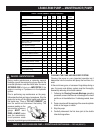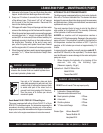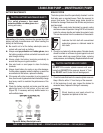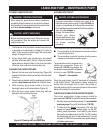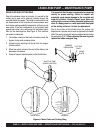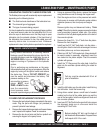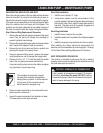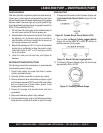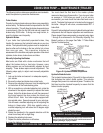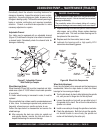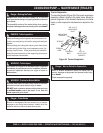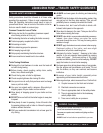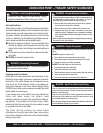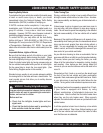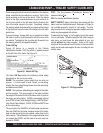
PAGE 44 — MAYCO LS400/LS500 PUMP — OPERATION AND PARTS MANUAL — REV. #6 (09/19/11)
LS400/LS500 PUMP — MAINTENANCE (TRAILER)
Trailer Brakes
Properly functioning brake shoes and drums are essential to
ensure safety. The brakes should be inspected the first 200
miles of operation. This will allow the brake shoes and drums
to seat properly. After the first 200 mile interval, inspect the
brakes every 3,000 miles. If driving over rough terrain, in-
spect the brakes more frequently.
Hydraulic Brakes
If your trailer has hydraulically-operated brakes, they
function the same way the hydraulic brakes do on your tow
vehicle. The hydraulic braking system must be inspected at
least as often as the brakes on the tow vehicle, but no less
than once per year. This inspection includes an
assessment of the condition and proper operation of the wheel
cylinders, brake shoes, brake drums and hubs.
Manually Adjusting the Brakes
Most axles are fitted with a brake mechanism that will
adjust the brakes during a hard stop. However, some
braking systems are not automatically adjusted by hard
stopping. These brakes require manual adjustment. The
following steps apply to adjust most manually adjustable
brakes.
1. Jack up the trailer and secure it on adequate capacity
jack stands.
2. Be sure the wheel and brake drum rotate freely.
3. Remove the adjusting-hole cover from the adjusting slot
on the bottom of the brake backing plate.
4. With a screwdriver or standard adjusting tool, rotate the
starwheel of the adjuster assembly to expand the brake
shoes. Adjust the brake shoes out until the pressure of
the linings against the drum makes the wheel very
difficult to turn. Note: Your trailer maybe equipped with
drop spindle axles. See axle manual for your axle type.
You will need a modified adjusting tool for adjusting the
brakes in these axles. With drop spindle axles, a
modified adjusting tool with about an 80 degree angle
should be used.
5. Rotate the starwheel in the opposite direction until the
wheel turns freely with a slight drag.
6. Replace the adjusting-hole cover.
7. Repeat the above procedure on all brakes.
8. Lower the trailer to the ground.
The following trailer maintenance guidelines are intended to
assist the operator in preventive maintenance.
Figure 45. Hydraulic Brake Components
You must check the fluid level in the master cylinder
reservoir at least every three months. If you tow your trailer
an average of 1,000 miles per month in a hot and dry
environment, you must check the brake fluid level once a
month. The brake fluid reservoir is located on the tongue of
the trailer. Always fill with clean, uncontaminated DOT 4
brake fluid.
Figure 45 below displays the major hydraulic/air/surge brake
components that will require inspection and maintenance.
Please inspect these components as required using steps
1 through 6 as referenced in the “Manually Adjusting The
Brakes” section on this page. See Table 11 Trailer Brake
System Troubleshooting.
Hydraulic Brake Actuator
The hydraulic brake actuator (Figure 46) is the mechanism
that activates the trailer’s brake system. This actuator
changes fluid power into mechanical power. Therefore, the
fluid level must be checked frequently to assure that the
brakes function properly.
Figure 46. Trailer Actuator
HYDRAULIC
BRAKE FLUID
RESERVOIR
Failure to maintain proper fluid level in the actuator may
result in loss of braking action which could cause severe
property damage, injury or death.
WARNING - Actuator Fluid Level



